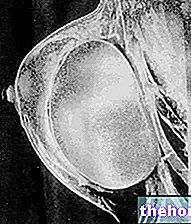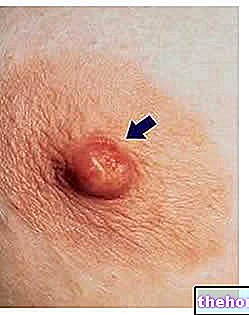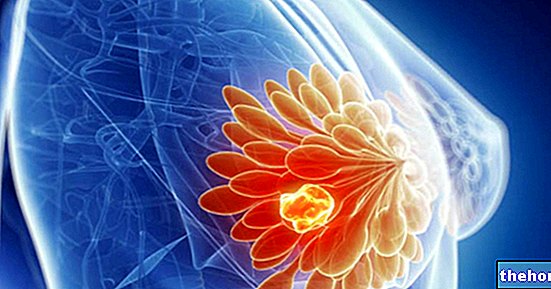Generality
Breast fissures are small cuts with a sharp edge, more or less deep, affecting the nipple and the surrounding areola.

- inadequate breast hygiene
- wrong attachment of the child
Symptoms Breast fissures "
Very common during the first weeks of breastfeeding, especially in primiparas, breast fissures appear as rather painful cracks, especially during sucking.These small cuts become an important problem when they cause a pain of such intensity as to discourage the baby's attachment to the breast, thus depriving him of the most recommendable food for his growth.
Furthermore, nipple fissures can represent an entry route for bacteria, with possible infection of the mammary glands (mastitis), especially in the case of non-breastfeeding or engorgement.
Preventing breast fissures: what to do before giving birth
Playing early in the last months of pregnancy can be a valuable aid in the prevention of breast fissures. For this purpose, some nipple rotation and stretching exercises can be performed:
- Rotation of the nipple: to favor its extension, grasp it between index and thumb making it rotate clockwise and counterclockwise.
- Nipple Stretching: Place your thumbs at the opposite ends of the areola (both vertical and horizontal) and perform gentle stretching movements.
Preventing nipple fissures: how to breastfeed and take care of your breasts
In most cases, nipple fissures recognize the incorrect positioning of the newborn as the cause of origin, which, sucking greedily from the nipple alone, produces excessive traumatism. The most effective intervention, both for preventive and therapeutic purposes, therefore concerns the correct attachment of the child, which is also useful for stimulating milk secretion.
- To latch on properly, the baby must open his mouth wide and insert the breast all the way, thus grasping a large part of the areola and not just the nipple.
- The baby should be lying on his side, with his belly against the mother's body and his head wrapped in the mother's embrace; the nipple must be at the level of the baby's nose, so that when he opens his mouth he will take it from the bottom up. the high.
- In the correct position, during the feeding a part of the areola will be visible above the baby's upper lip, while it will not be visible under the lower lip, which will appear upside down on the outside; the baby's cheek will appear swollen and round, devoid of the typical sucking dimples of a bottle, while the chin and nose will remain in contact with the breast.
- Adopt a different position at each feeding (sitting, side, lying down) in order not to irritate the nipple and to allow the baby to apply pressure in different areas of the nipple and the areola; this precaution prevents both the appearance of irritation and fissures in the breast, that of breast engorgement.
- Before attaching the baby to the breast, check that his nose is completely free, so that he can breathe while sucking.
- At the end of the feeding, the baby will spontaneously detach from the breast; if it is necessary to remove it prematurely, the operation will be performed by placing a finger at the corner of the mouth, stimulating it and then pushing the breast downwards; all this to save the nipple from unnecessary "tearing" and tension resulting from a too abrupt detachment.
- When the baby is latched on correctly, decreasing the duration of the feed does not protect the nipple from breast fissures; during the feeding the mother will be able to hear the correct noise generated by swallowing (glu-glu), without any pop that would represent the indicator of a vacuum sucking. In any case, if you notice that the baby remains attached for too long, it is good to detach him as listed in the previous point. Feeding should not take longer than 25-30 minutes to prevent the nipple from becoming irritated or the baby suckling.
- The appearance of breast fissures must not cause breastfeeding to be suspended, as they tend to spontaneous healing once the root causes have been removed. Only in the case of bleeding fissures is it advisable to suspend breastfeeding and resort to the use of healing and antibacterial medicines under medical supervision.
Breast fissure treatment: is there a useful treatment?
To prevent breast fissures it is very important to have a thorough hygiene of the same.
- Before feeding, your hands should be adequately cleansed with lukewarm water. To clean the nipples, avoid soap or other aggressive detergents, possibly resorting to the comfortable wipes specific for its cleansing (make sure that the components are natural and do not need to be rinsed, also check the absence of surfactants that dry the skin or perfumes that could change the natural smell of the breast and disturb the baby). The ideal is to use boiled water and a sterile gauze to gently cleanse the feeding area, with movements that go from the nipple to the areola.
- At the end of the feeding, dry the nipples in the air or pat them without rubbing. This operation is important to avoid skin maceration caused by wearing the bra while the nipple is still wet; eventually, after feeding, the breasts can be covered with absorbent and transpiring cups, to be changed as soon as they moisten.
- You don't need to wash your breasts more than once a day, or use soaps or rub them hard with a towel. Water and detergents, in fact, remove the natural protective fats of the skin and can dry it out and make it more prone to irritation and cracking.
- Gently letting a few drops of milk come out of the breast, and spreading it around the nipple, can be helpful both before feeding, to soften the areola, and at the end of it, to promote the healing of any cracks.
- For the treatment and treatment of irritations that can turn into painful fissures, many experts advise against the use of specific medicinal ointments or lotions, which could irritate the skin without bringing real benefits, but also give the milk an unpleasant taste. Generally, to prevent the formation of breast fissures, vegetable oils are used, such as sweet almond or St. John's wort.






















-nelle-carni-di-maiale.jpg)




